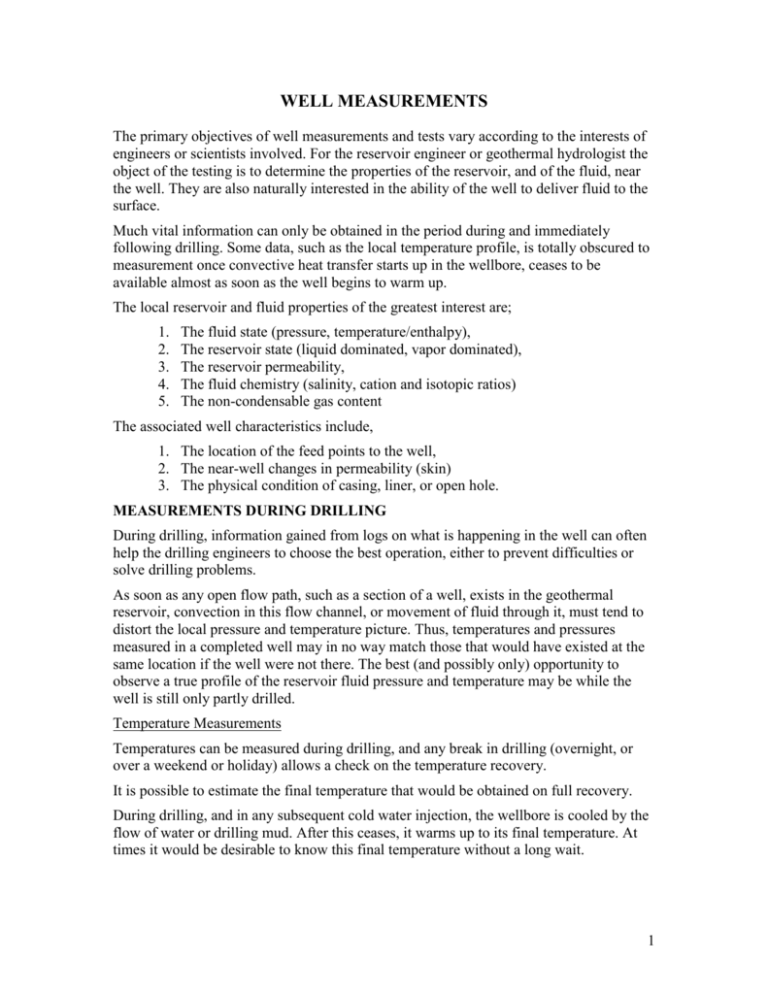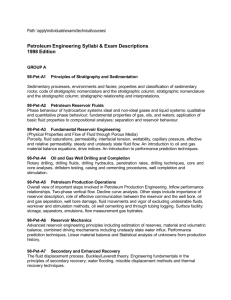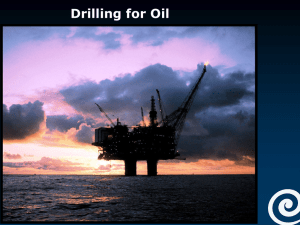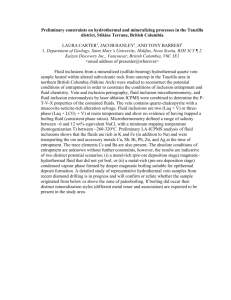Well Measurements
advertisement

WELL MEASUREMENTS The primary objectives of well measurements and tests vary according to the interests of engineers or scientists involved. For the reservoir engineer or geothermal hydrologist the object of the testing is to determine the properties of the reservoir, and of the fluid, near the well. They are also naturally interested in the ability of the well to deliver fluid to the surface. Much vital information can only be obtained in the period during and immediately following drilling. Some data, such as the local temperature profile, is totally obscured to measurement once convective heat transfer starts up in the wellbore, ceases to be available almost as soon as the well begins to warm up. The local reservoir and fluid properties of the greatest interest are; 1. 2. 3. 4. 5. The fluid state (pressure, temperature/enthalpy), The reservoir state (liquid dominated, vapor dominated), The reservoir permeability, The fluid chemistry (salinity, cation and isotopic ratios) The non-condensable gas content The associated well characteristics include, 1. The location of the feed points to the well, 2. The near-well changes in permeability (skin) 3. The physical condition of casing, liner, or open hole. MEASUREMENTS DURING DRILLING During drilling, information gained from logs on what is happening in the well can often help the drilling engineers to choose the best operation, either to prevent difficulties or solve drilling problems. As soon as any open flow path, such as a section of a well, exists in the geothermal reservoir, convection in this flow channel, or movement of fluid through it, must tend to distort the local pressure and temperature picture. Thus, temperatures and pressures measured in a completed well may in no way match those that would have existed at the same location if the well were not there. The best (and possibly only) opportunity to observe a true profile of the reservoir fluid pressure and temperature may be while the well is still only partly drilled. Temperature Measurements Temperatures can be measured during drilling, and any break in drilling (overnight, or over a weekend or holiday) allows a check on the temperature recovery. It is possible to estimate the final temperature that would be obtained on full recovery. During drilling, and in any subsequent cold water injection, the wellbore is cooled by the flow of water or drilling mud. After this ceases, it warms up to its final temperature. At times it would be desirable to know this final temperature without a long wait. 1 One approach has been to use a Horner plot. - During the measurement, there should be no circulation of fluid within the well, - The depth at which the recovery is observed should not be a zone of circulation loss. Procedure: 1. The well is cooled for a time tp by drilling. Time tp is defined as the time that the formation, at the depth under study, has been exposed to circulating fluid. This would usually be the time since the drill bit passed the particular depth. 2. Circulation is halted, and the temperature is measured at several times t afterwards. 3. The data are plotted on a Horner plot and extrapolated to t = ∞, i.e. (tp+t)/ t = 1, to obtain an estimate of final temperature. The validity of the Horner plot is based on the observation that the equation for the transient temperature in the formation around a well as a function of radial distance and time is given by the following PDE in terms of dimensionless variables, 2 TD 1 TD TD rD rD t D rD2 which is of the same form as the pressure transient equation, Initial condition: TD (rD, 0) = 0 Inner boundary condition: TD (1, tD) = 1 Outer boundary condition: lim rD ∞ TD (rD, tD) = 0 The dimensionless quantities in the above equation are defined as, TD Ti T(r, t) tD T i Twf Kt Cρ rw2 rD r rw 2 Where: Ti = Initial reservoir temperature, K T(r,t) = Reservoir temperature at r at the time of t, K Twf = Temperature at the well face, K K = Rock conductivity, W/mK C = Specific heat of rock, J/kg K = Density of rock, kg/m3 rw = Wellbore radius, m This equation governs the cooling and warming of the well provided that conduction is the dominant mechanism of heat transfer. It is not valid at any zone of fluid loss, at any other permeable zone, or if circulation of fluid occurs spontaneously in the wellbore past the depth of observation. There is an additional problem. The condition imposed at the wellbore during circulation is, approximately, T=constant, rather than heat flux is constant. Therefore the temperature recovery is strictly analogous to a pressure recovery after discharge at constant pressure. The Horner plot, in this case, will yield an underestimate of the final temperature. An improved method is given by Roux et. al1: - A Horner plot is made and extrapolated to an apparent final temperature T*ws. Then the final temperature is computed as, * T Tws mTDB (t pD ) Where m = the slope of the Horner straight line, TDB = Dimensionless correction term, dependent on the dimensionless tpD and on the Horner time ratio The term tpD is defined as t pD Where Kt p ρC rw2 ρC 1 φρ r C r φρ f Cf = Porosity, fraction Subscripts r and f stand for rock and fluid, respectively. 1. Roux, B., Sanyal, K., Brown, S.L., “An Improved Approach to Estimating True Reservoir Temperature from Transient Temperature Data”, SPE paper 8888, 50 th Annual California Regional Meeting of SPE, LA, California, April 9-11 1980. 3 Some important aspects of temperature measurements are as follows; - Temperature logs very seldom show the true rock temperature in the well. - During drilling the circulation fluid will change the temperature considerably. - Disturbances caused by circulation, injection of water and other heat transfer operations give valuable information on the locations of water entries and zones of circulation losses. Figure 1 gives the four examples of disturbed temperature profiles for a three aquifer well. For each example a linear rock temperature profile is used as a reference. Figure 1. Temperature profiles in a well with three aquifers at depths a, b, and c. 4 Cases A and B correspond to temperature profiles during injection. Profile is dependent on whether the injected fluid is lost at the aquifers or whether there is an additional fluid entry at some of the aquifers. A fluid-loss zone Change in the temperature gradient Fluid entry Discontinuous jump in the temperature itself A quantitative estimate of the amount of fluid lost or gained at the aquifers is possible if the heat flux through the walls of the well can be considered constant throughout the well (the heat flux together with the flow defines the temperature gradient between two loss zones) or if the original temperature of the fluid entering the well at an aquifer is known. Figure 2. Fluid entry into the well during injection To, qo = Temperature and fluid flow above the water entry, T1, q =Temperature and amount of fluid entering the well at the aquifer, To qo T = Temperature below the water entry T1 q The conservation of mass and heat gives, (q o q)T q o To qT1 T qo+q q qo T To T1 T The above equation also applies to free flow from a well (Case C) if the words below and above are interchanged in the definition of T, To, and qo. The temperature disturbances below the deepest aquifer on Case C will die away during recovery and the temperature align itself to the true rock temperature. Finally Case D shows that aquifers can be seen in the temperature profile of a closed well free from fluid flow either as a positive or a negative anomaly in the temperature log. The location of aquifers is of general interest in geothermal investigation. The location of loss zones together with the amount of fluid lost will, during drilling, be a crude measurement of the success of the drilling operation, and may in some cases determine the final depth of the well. 5 Example: The following figure shows the temperature profile during injection of cold water in Well SG-7 in Svartsengi, Iceland. Reservoir temperature in Svartsengi is approximately 240 °C and the calculated inflow in the well is 28 l/s when 25 l/s of 7 °C cold water is injected into the well. Figure 3. Temperature profile during cold water injection in Well SG-6, SvartsengiIceland. Aquifers are also of interest in the cased part of the well as it is usually preferred to cement all such major loss zones off before the casing is run into the well and cemented. This is done to minimize the risk of bad cementing of the casing. Although the use of temperature logs during drilling has so far only been mentioned as a tool to localize aquifers, the temperature itself can be of interest, as the two following examples will show: 1. The lubricator used in ordinary drill bits cannot stand higher temperatures than 100 – 150 °C. If the well can not be cooled by a cold water injection a temperature log will show how deep into the well it is safe to sink the drill bit 6 before it is necessary to slow down and start cold water circulation to protect the drill bit. 2. The BOP valves cannot be applied for one or two days during running the casing or a liner into a well. Hence there is a potential blowout risk. If the temperature response of the well is studied before the drill string is taken out of the well, the blowout risk during the casing operation can be estimated. Caliper Log: The caliper log gives the location of cavities in the well. During drilling cuttings will accumulate in all major cavities and cause a potential risk of the drill string becoming stuck in the well. Caliper logs are also commonly used to inspect casing for damage either during drilling or later in the lifetime of a well. Depositions in wells are also clearly seen on caliper logs (Figure 4). Figure 4. The formation of calcite scaling in SG-4, Svartsengi-Iceland. 7 MEASUREMENTS DURING WARM-UP Temperatures during warm-up Firstly, remember that the temperature log shows the temperature inside the well, and the value recorded need not be that of surrounding rock. The temperature usually increases with depth, but quite different profiles can occur (Figure 5). Figure 5. Temperature profiles in deep drill holes in Iceland. As the well and the surrounding rock are cooled down during drilling it takes the well some time to recover its initial pressure. It depends on the properties of the well whether the aquifers warm-up more rapidly than the “dry” rock part of the well. As the warms, there are four ways in which the heat may reach the wellbore: 1. By conduction through the surrounding formation, 2. By direct flow of fluid into the wellbore at one level and out another (inter zonal flow), 8 3. By convection cells within the wellbore, 4. By flow directly across the well. The impermeable zones have been cooled conductively; the permeable ones have been cooled by their acceptance of cold water and drilling fluid. The fluid transfer into these zones can often cause them to initially appear as abnormally cold regions. When a well is not flowing, the aquifers usually warm up more slowly than the rest of the well. If on the other hand a fluid flow or boiling exists in the well the reverse situation can easily occur. In Figure 6, an example of a well where the aquifers at 290 m and at 450 m depth warmup faster than the lower part of the well is shown. The well is flowing and the temperature above the aquifers is disturbed by the water flow. Figure 6. Temperature logs in well no 2 at Laugar-Iceland. 9 When no flow is in a well, the aquifers usually warm-up more slowly than the impermeable rock. An example of this is shown in Figure 7. This behavior is explained by the penetration of circulating fluid, during drilling, into the aquifers (more permeable) causing more effective cooling there than in the impermeable rock. Provided that the cold water does not flow back into the well, the heat in the surrounding rock is needed to warm-up the cold water. Hence, the aquifer warms-up more slowly than the impermeable rock. Figure 7. Temperature profiles in well H-2, Tungudalur-Iceland. 10 Constant Temperature Gradient: This type of temperature log is probably globally the most common temperature profile measured. Such temperature profiles are interpreted as being the result of heat conduction in the crust. The heat flow then follows the equation; QK ΔT Δz As the thermal conductivity, K, of rock is fairly constant; the temperature will be a linear function of depth. T To ΔT z Δz Where; Q = heat flow T = temperature To = annual mean temperature at surface Z = depth Flow between different aquifers: Flow between different aquifers is common in closed wells. Usually it is a downward flow from an upper aquifer to a lower one. The temperature profile in such cases is characterized by a fairly constant temperature over a large interval in the well. (Reminder: The cross flow in contrast, is characterized by a single isolated peak in the warm-up profiles) An example of inter zonal flow is given from the measurements in well OK5, Okoy Field-Philippines. These profiles show an inter zonal flow between 1100 m and 1550 m, and consequently, permeability at both these levels. Figure 8. Temperature profiles in well OK-5, Okoy-Philippines. 11 The Static Well: Most wells will adjust to a stable pressure and temperature state if they are left shut sufficiently long. However, neither the pressure nor the temperature profiles will necessarily correspond to those of the reservoir. Their form and the closeness of the correspondence depend strongly on the reservoir pressure gradient ant the distribution of feed points in the well, including the permeability distribution. When there is no flow between aquifers, the temperature in the well will usually reach equilibrium with the surrounding rock. However, processes like boiling accompanied by one-dimensional convection can disturb the temperature profile in the well. Negative Temperature Gradient: A negative temperature gradient means that the temperature decreases with depth in a part of the well (Figure 9). This has been observed in high temperature wells as well as in low temperature geothermal fields. Figure 9. Temperature log in well 8, Krisuvik-Iceland. In some cases there has been disagreement about the interpretation of a negative temperature gradient. However, the most acceptable explanation seems to be the association of the negative temperature gradient with non-vertical water flow in the formation (Figure 10). A negative gradient should also exist in parts of a field like Wairakei, if the mushroom shaped model suggested for it is correct (Figure 11). In a laboratory experiment with a two-dimensional convection cell with limited size of heating element at the bottom, it can be shown that a negative gradient should be present (Figure 12). 12 Figure 10. Negative temperature gradient caused by horizontal flow. Figure 11. Mushroom-shaped model of the Wairakei filed, New Zealand. 13 Figure 12. Temperature distribution corresponding to free convection in a Hele-Shaw cell. Boiling effects observed in temperature profiles of closed wells: All high temperature wells tap reservoirs of higher temperature than 100 °C. Boiling and steam accumulation will therefore always be present in those wells during discharge and sometimes even when they are closed. The boiling point of water is defined by two parameters, temperature and pressure. At atmospheric pressure water boils at the well known temperature of 100 °C. If the pressure is higher a higher temperature is needed to reach the boiling point. It is common in temperature log interpretation to compare the temperature profiles measured in closed wells with a boiling point curve or more correctly with a boiling point profile. This curve is derived from the steam tables by assuming that the water column in the well is at boiling point temperatures from the water level down to the bottom of the well. The comparison shows immediately where boiling can possibly occur in the well. In Figure 13, two types of temperature profiles for a well in thermal equilibrium are shown; Profile A: It shows relatively constant temperature of 200 °C between 300 and 1100 m depth. Below that level the temperature increases rapidly to more than 300 °C at 1300 m depth. Profile B: This profile shows an increasing temperature with depth. At the bottom the temperature is a little lower than in Profile A, but above 1200 m the temperature values in Profile B are higher than in Profile A.Temperature profile is the one showing the undisturbed formation temperature. 14 The reason for the transition from Profile A to Profile B is the pressure drawdown in the well and the geothermal system due to production from near-by wells (note that KG-5 has never discharged). The drawdown (6 bar in this case) lowers the boiling point and intensifies the boiling in the bottom part of the well. Steam bubbles accumulate there, move up hole, condense and warm up the water higher up in the well. This kind of heat transfer is called one-dimensional convection and has been observed in several wells in Iceland. Figure 13. Temperature profiles in well KG-5, Krafla-Iceland. Temperature profiles of flowing steam wells: When a steam well in a liquid-dominated field starts to flowing, boiling will begin at those well depths where the temperature and the pressure correspond to points of saturation. Until temperature and pressure equilibrium is reached, the boiling level will be moving, generally down the well. An example of this kind of flow is shown in Figure 14, where both temperature and pressure are shown for a flowing well. According to temperature and pressure profiles, boiling level is at approximately 300 m depth. In the two-phase zone, above 300 m depth, the temperature and pressure are saturated. The decreasing pressure gradient indicates the increasing vapor fraction as the mixture flows upwards and flashes to adjust the temperature to the saturation curve. 15 In cases of near saturation temperature or low permeability, boiling level will be reached below the deepest aquifer in the well. In this case boiling starts outside the well and both temperature and pressure in the well are fairly constant down through the two-phase zone. Figure 14. Temperature and pressure measured during discharge of well KJ-9, KraflaIceland. 16 Figure 15 gives the temperatures measured in WK10 over 20 years. There exists an apparent and consistent decline in temperature for all these years. However this is only a deceit. The interpretation presented here is that reservoir temperatures have never been changed. In this well some drilling temperatures are available – measured at or near bottom hole during the drilling of the well. As at most a day’s warm up is allowed, these temperatures are certain to be somewhat low. However the drilling reports make it clear that considerable cool ground was drilled, before reaching hot and gassy conditions at around 800 ft. Thus the drilling temperatures do approximately represent real reservoir temperatures. The temperatures after completion show much hotter fluid in the well, except near well bottom. This merely reflects the rise of such hot fluid from near bottom hole. This is normal behavior in an unexploited reservoir. With time, and presumably some small pressure drop near the well bottom, the upflow diminishes and conductive cooling of the fluid in the well becomes important. As it becomes more important, progressively cooler fluid is found in the well. However, the measured temperatures in the well above the well bottom still exceed reservoir temperatures. The apparent steady temperature fall might have been interpreted as indicating cold water advance. In fact it merely reflects a pressure drop (a small one) in the reservoir near well bottom, reducing the ability of the well to mask the true temperature profile. It can be stated as a general principle that downhole measurements are dominated by fluid flow and fluid state, within the well, and between the well and the reservoir. Their correct interpretation requires an analysis of what the fluid in the well is doing. Only in wells of poor permeability is convection so weak that great detail can be observed in the reservoir temperature profile. 17







